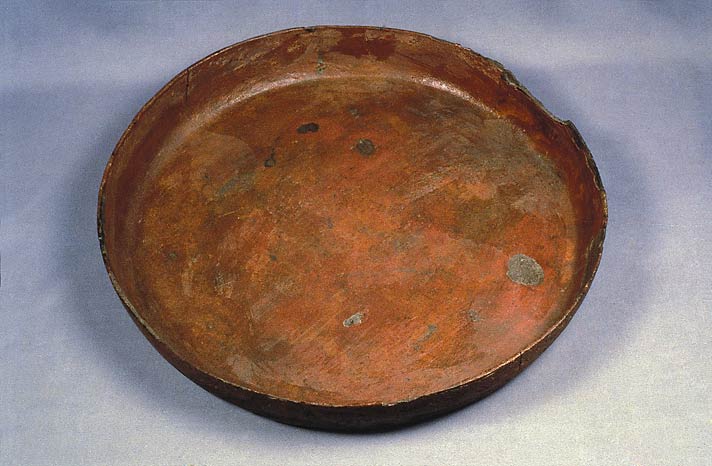
Plate with vertical sides. Copper and bronze plates were probably used exclusively by wealthy upper class city dwellers. Discovered in 1938.
What is known about the food habits of the Indus Valley people? Have any cooking utensils/equipment, charred remains of food or agricultural implements been found? Wheat kind of bread was their staple, perhaps baked in ovens or cooked over fire? Did they grow lentils - one of the key elements of sub-continental food? Submitted by Colleen
Jane McIntosh
The Harappans grew lentils and other pulses (peas, chickpeas, green gram, black gram). Their main staples were wheat and barley, which were presumably made into bread and perhaps also cooked with water as a gruel or porridge. In some places, particularly Gujarat, they also cultivated some native millets; possibly broomcorn millet, which may have been introduced from southern Central Asia; and by 2000 BC, if not before, African millets. They fed local wild rice to their animals and probably began to cultivate it, though rice does not become an important crop until Post-Harappan times. The Harappans must have eaten a range of fruit, vegetables and spices : these included a variety of brassica, brown mustard greens, coriander, dates, jujube, walnuts, grapes, figs; many others, such as mango, okra, caper, sugarcane, garlic, turmeric, ginger, cumin and cinnamon, were locally available and probably grown or gathered by the Harappans, but the evidence is lacking. Sesame was grown for oil, and linseed oil may also have been used.
Meat came mainly from cattle, but the Harappans also kept chickens, buffaloes and some sheep and goats, and hunted a wide range of wildfowl and wild animals such as deer, antelopes and wild boar. They also ate fish and shellfish from the rivers, lakes and the sea; as well as being eaten fresh, many fish were dried or salted – many bones from marine fish such as jack and catfish were found at Harappa, far inland.
Harappan houses had a kitchen opening from the courtyard, with a hearth or brick-built fireplace. Pottery vessels in a range of sizes were used for cooking; in wealthy households metal vessels were also used.
Few certain agricultural tools have been found. Flint blades were probably used for harvesting. A ploughed field at Early Harappan Kalibangan shows that the plough was in use by the early 3rd millennium BC; its criss-cross furrows allowed two crops to be raised in the same field, a practice that has continued into modern times.
Richard Meadow
We have a good deal of evidence for Harappan subsistence. Staple crops varying by region and time period included wheat, barley, millets, rice, and pulses. For details, see the following:
Fuller, D. (2002) Fifty Years of Archaeobotanical Studies in India: Laying a Solid Foundation in S. Settar and R. Korisettar (eds.) Indian Archaeology in Retrospect, Volume III. Archaeology and Interactive Disciplines, Publications of the Indian Council for Historical Research. New Dehli: Manohar: Pp. 247-364.
Fuller, D. (2003) African crops in prehistoric South Asia: a critical review in K. Neumann, A. Butler and S. Kahlheber (eds.) Food, Fuel and Fields. Progress in Africa Archaeobotany, Africa Praehistorica 15. Colonge: Heinrich-Barth-Institut: Pp. 239-271
Fuller, D. (2003) Indus and Non-Indus Agricultural Traditions: Local Developments and Crop Adoptions on the Indian Peninsula, in S. Weber and W. Belcher (eds.) Indus Ethnobiology: New Perspectives from the Field. Lexington Books, Lanham, Maryland: Chapter 10.
Fuller, D. Q (2005). "Ceramics, seeds and culinary change in prehistoric India." Antiquity 79 (306): 761-777.
Fuller, D. Q and E. L. Harvey (2006). "The Archaeobotany of Indian Pulses: identification, processing and evidence for cultivation." Environmental Archaeology 11(2): 219-246.
Fuller, D. Q (2006). "Agricultural Origins and Frontiers in South Asia: A Working Synthesis." Journal of World Prehistory 20: 1-86
For animals, the domesticates humped cattle, sheep, goat, and perhaps water buffalo were of principle importance for both primary (after death) and secondary (before death) products. See:
Meadow, R.H. and A.K. Patel (2003) Prehistoric pastoralism in northwestern South Asia from the Neolithic through the Harappan Period. In S. Weber and W. Belcher, eds., Indus Ethnobiology: New Perspectives from the Field. Lanham, MD: Lexington Books (Rowman & Littlefield Publishing Group), pp. 65-93.
Both wild animal and wild plant resources continued to be important including fish, molluscs, hunted animals, and various wild plants for fodder, food, and medicines. Linen, cotton, and wool were important resources for textile manufacture, and silk was also used., coming from wild silk moths. For the last, see:
Good, Irene, J.M Kenoyer and R.H. Meadow (2009) "New evidence for early silk in the Indus Civilization." Archaeometry 51: 457-466.
